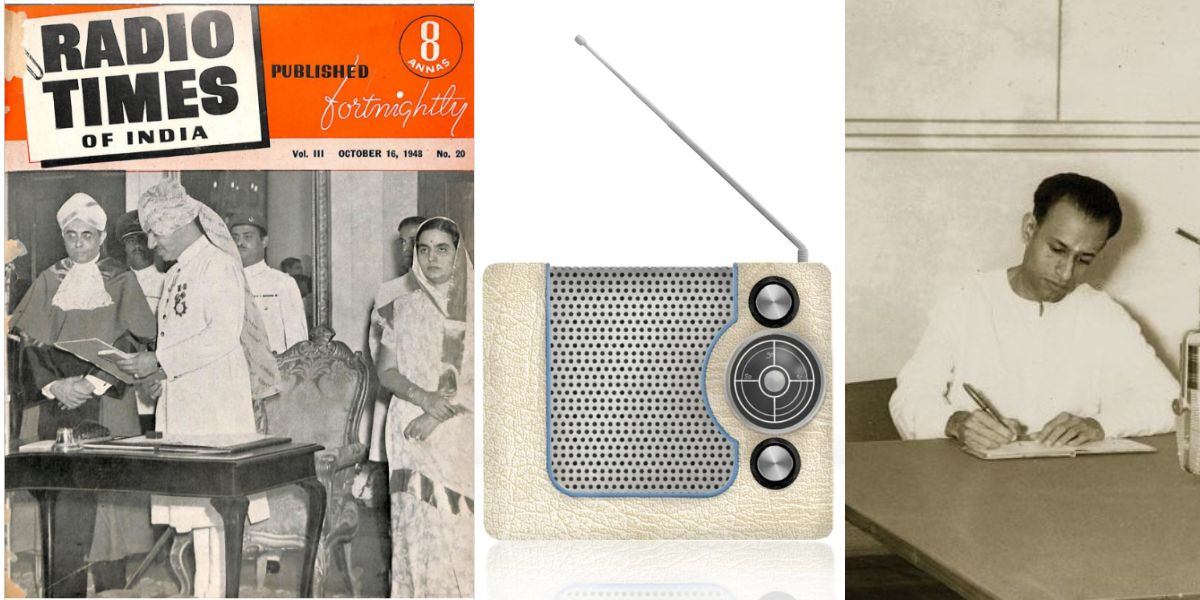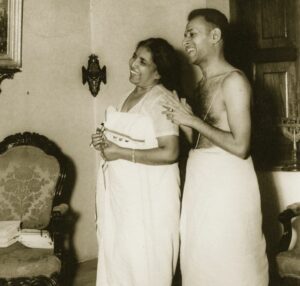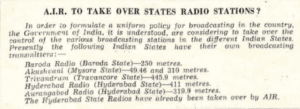National Broadcasting Day is observed on 23 July every year to commemorate the first-ever radio broadcast from the Bombay Station in 1927.

A cover of Radio Times of India, a vintage Radio, Sree Chithira Thirunal.
Eighty years ago — to be precise, on 12 March, 1943 — residents of the erstwhile kingdom of Travancore, or Thiruvithamkoor, tuned their ears for a historic moment.
As they gave ear to the salutation “This is Trivandrum Calling”, their seven years of waiting for a broadcasting service from Travancore was also coming to an end.
Moreover, Travancore became one of the four princely states to have their own broadcasting transmitters. Others were Baroda, Mysore, and Hyderabad.
The welcome message had come from a temporary studio set up at the transmitting station in Pangappara (now a suburb of Thiruvananthapuram).

Sree Chithira Thirunal with his mother Setu Parvathi Bayi. (History Liberated The Sree Chithra Saga/Konark Publishers)
It came after Setu Parvathi Bayi, mother of the then-king Sree Chithira Thirunal, formally inaugurated the first regular broadcasting service that began on that day.
The salutation was followed by a vocal concert by veteran musician Semmangudi Srinivasa Iyer.
Though the objective of starting the broadcasting service was to uplift the spirits of people (as it was the time of World War II) and improve the living conditions of people through various awareness programmes, it was also used as a medium to counter anti-government moves.
Before its formal launch, test transmissions from the broadcasting station had gone on the air from 22 November, 1942.
It was in 1936 that the idea of having a broadcasting service for Travancore germinated.
The Report on the Progress of Broadcasting in India (up to 31 March, 1939), published by the Office of the Controller of Broadcasting, stated: “Early in 1936, the trade agent for the Travancore state at Bombay consulted the Controller of Broadcasting to draw up a comprehensive scheme of broadcasting for Travancore state.”
It added, “The Maharaja of Travancore (Chithira Thirunal) evinced great interest in the subject and a committee was formed of responsible officials in the state to advise on the possibilities of erecting a transmitter at a suitable site in Trivandrum.”
The report then stated that advice was sought through correspondence on almost all aspects of broadcasting, and detailed information was given.
To set up a broadcasting station, the government earmarked ₹1.50 lakh in the budget estimates for 1938.
Addressing a joint session of the Travancore Sri Mulam Assembly and the Travancore Sri Chitra State Council on 21 July, 1937, the then financial secretary A Rengaswami Aiyar stated, “The government has under consideration the installation of a broadcasting station for serving the whole state (Travancore) including rural areas.”
He added: “Although not expected to be fully remunerative, the scheme is expected to pay a portion of the working expenses.”

A report appeared in the fortnightly Radio Times of India on 16 October, 1948 regarding the takeover of broadcasting transmitters of princely states including Travancore by the government of India
However, he added that details had not been worked out yet.
But within a gap of 10 days, the government estimated the amount needed to start a broadcasting station in Trivandrum.
On 31 July, 1937, electrical engineer to government KP Padmanabha Menon informed the Assembly that an amount of ₹2.33 lakh was needed to fructify the idea.
The estimation was revised on 24 November, 1937, as the government prepared a scheme for establishing broadcasting stations in Travancore. This time the estimated cost stands at ₹3.78 lakh.
Answering a question at the Assembly, government secretary K Paramsesvara Panickar said that the scheme had been prepared with the help of Cecil Goyder, who was the chief engineer of All India Radio (AIR).
As per the plan, one 5-kilowatt medium-wave transmitter would come up at Trivandrum — modern-day Thiruvananthapuram.
Besides that, 100-watt medium-wave transmitters would come up at stations like Trivandrum, Quilon (now Kollam), Alleppey (now Alappuzha), Kottayam, Munnar, and Nagercoil (now in Tamil Nadu).
Goyder’s visit to Travancore in January 1939 finally convinced the government to proceed with the broadcasting centre at Trivandrum.
As per a Travancore Administration Report, the expenditure on this scheme till the end of 1943 was ₹1.23 lakh.
The government, which was determined to come out with a world-class broadcasting experience for people, sent officers to training including at British Broadcasting Corporation (BBC) and ordered equipment from
abroad.
Substantiating it is an answer given by KPP Menon on 28 July, 1943, in the Assembly.
According to him, five officials — MV Rama Varma Raja, R Sundararaman, MJ Joseph, Abraham Muthalaly, and AB Thomas — had their training in the AIR stations at Delhi, erstwhile Bombay, erstwhile Madras, Lucknow, and Lahore.
Of them, Rama Varma Raja was sent to the BBC for training and was appointed as director of the Trivandrum Broadcasting Station upon return.
According to GPS Nair, who was director of AIR Trivandrum in 1950, one more official was sent abroad: P Ramankutty Nair was sent to the US for training in engineering.
For the equipment, Menon said that though the erection of the transmitter had been completed, the completion of the works in all respects depended upon the availability of a large number of essential spare parts which were on order — mostly from abroad.
He added, “In the meantime, the transmitter is working regularly once every week.”
In March 1942, Menon stated in the Assembly that the transmission equipment was ordered from M/s Standard Telephone Co, Calcutta. And except for one induction regulator, one air blower, and seven valves with some minor accessories, all had arrived.
He added, “The firm has been asked to intimate the date by which their erector could be expected for taking up the erection of the types of equipment and their reply is awaited.”
However, he was sceptical about when the broadcasting could be started as “in the present conditions it is not possible to say when the scheme can be worked and programmes released. But it turned out that exactly a year later, regular broadcasting was carried out.
It is said that owing to war conditions, the station commenced work only with one transmission per week (on Fridays from 7 pm to 9 pm).
However, special transmissions were arranged on important occasions such as Onam, Navaratri, and the Maharaja’s birthday celebrations. Radio dramas were also played.
In the Travancore Directory of 1948, a brief account of the development of Trivandrum Broadcasting Station and its services was given.
The studio of the station, which was operated from one of the rooms in the transmitting station in Pangappara, was shifted to a new location.
The broadcasting house now stands at Palayam, which now houses the MLA Quarters, and is connected with the transmitter by overhead high-grade telephone lines.
As per the directory, it was from April 1945 that bi-weekly transmissions were introduced — on Tuesdays and Fridays. Then it got increased to four days — Tuesdays, Wednesdays, Thursdays, and Fridays — in 1946.
From August 1947, daily transmission for two hours in the evening was arranged.
The programmes generally consist of “talks and recitations in English, Malayalam, and Tamil; short and long plays in Malayalam and Tamil; indigenous arts like Ottanthullal and Kathakali; music concerts; story performances in Malayalam and Tamil; recorded music and teachings of Sri Swati Tirunal’s compositions; and others”, read an excerpt from the directory.
It added that a scheme for starting the Rural Uplift Programme was also on the cards.
The book This is All India Radio, published in 1983 by the Union Ministry of Information and Broadcasting, mentioned that when the princely states were integrated with India, low-power radio stations at Mysore, Trivandrum, Hyderabad, Aurangabad, and Baroda were taken over by AIR and became a part of the network by 1950.
“While Baroda was taken over on 16 December, 1948, Trivandrum, Mysore, Hyderabad, and Aurangabad were integrated by 1 April, 1950.”
As Travancore Radio became AIR Trivandrum, it got a new address as the office got shifted from Palayam to Bhaktivilas in Vazhuthacaud in 1952.
The latter was the official residence of the diwan of erstwhile Travancore and has continued to be the office of AIR Trivandrum for the past 71 years.

May 07, 2024

May 07, 2024

May 07, 2024

May 07, 2024

May 06, 2024

May 06, 2024